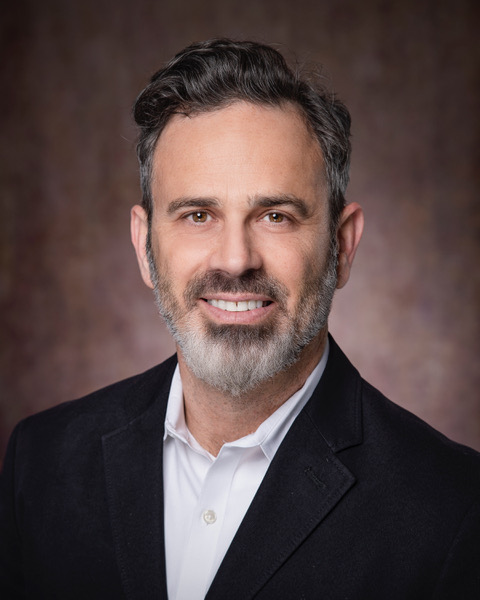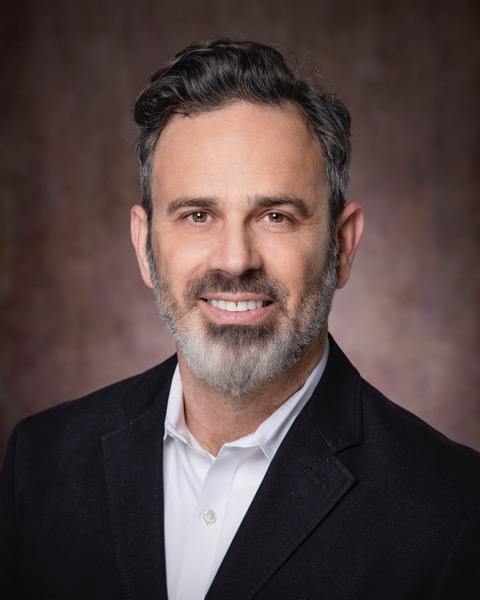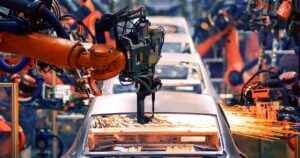Federal funding for America’s public electric vehicle charging network flows through Gabe Klein.
Last year, Klein was a well-known thought leader for the transportation mobility set. He previously led the transportation departments in Chicago and Washington, D.C., created his own mobility consultancy and has invested in and advised transportation startups. If you had questions about electric scooters and city policy, he was among the first people you’d call.
Today, Klein is at the forefront of America’s attempts to build out many more public EV chargers as the domestic market for EVs ramp-up. He’s been tasked with heading up a first-of-its-kind Joint Office of Energy and Transportation, established between the Departments of Energy and Transportation, and he’s got $7.5 billion in EV infrastructure funding to hand out.
GreenBiz sat down with Klein seven months into the job to discuss what the joint office will do for charger reliability, EV affordability and urban renters who want EVs. This conversation was edited and condensed.

![]()
![]()
![]()
![]()
![]()
![]()
![]()
![]()
![]()
Katie Fehrenbacher: Why does the U.S. need a joint office between transportation and energy specifically now at this time?
Gabe Klein: There are so many reasons. For one thing, when [President Joe Biden] spearheaded this, working with Congress, they quickly realized that they had to break down the silos between energy and transportation.
Transportation is the largest emitter of greenhouse gas emissions since 2016. And you can't really separate one from the other if you're going to address these issues. The president also talks about the fact that this is a huge opportunity to create jobs.
A few things were clear to me from the early days. One is they wanted to break down the silos and really focus on outcomes for the citizenry. Two, they were really serious about equity and Justice40 [the program focused on ensuring federal investments reach underserved communities]. And three, they weren't giving lip service to climate issues. But this was a very serious issue for the administration and a pillar from a policy standpoint.
Fehrenbacher: You've been on the job a little over seven months. What are some of the biggest lessons you've learned so far?
Klein: I came from the transportation sector, and I've always had a deep interest in energy and climate. Having said that, the energy industry is going through a complete shift as the transportation space has gone through over the last decade as well. So I would say that, for me, there's definitely been a learning curve getting up to speed. There’s just amazing expertise at DOE that I've been able to tap into to learn from. And there's an opportunity for me to teach in terms of my background and what I bring to the table.
This is all new for a lot of people. We've only been building EVs seriously for 20 years, and what's behind that with renewable and distributed energy. We’re talking about a paradigm shift with how the economy works and not powering it with fossil fuel anymore. When you put it all together, you realize everybody's learning; even the experts are learning.
But we don't just want to have a hammer, we want to have a carrot as well, right? And so we want to also work closely with industry to make sure that they can meet those standards.
A study came out [recently] saying 47 percent of people said that they wouldn't buy an EV as their next car. I thought 53 percent was pretty awesome, considering we’re in 2023. I think by 2024, ‘25, ‘26, that number is going to be upwards of two-thirds of the country. And then upwards of 80 or 90 percent.
And then the other side of that coin, of course, is that a lot of people live in urbanized areas, and people may not be buying as many vehicles, they may be accessing vehicles [via other models] whether it's Hertz, who has 360,000 EVs on order, or car share or ride hail or electric bikes and scooters. We're going to continue to see a shift in the way people move on top of the way that people use energy.
Fehrenbacher: Speaking of urban living, I live in San Francisco in a rental apartment, and so far I've been frustrated that I can't participate in owning an EV. How is the joint office helping that issue of charging and multi-tenant dwellings?
Klein: If you look at our mission, it's for everybody to be able to ride or drive electric. We don't necessarily want to force an urban dweller like yourself to go out and buy a vehicle if your life is perfectly fine using transit, using bikes and having the occasional access to a rental or a ride hail vehicle. But if you decide that, hey, you need to buy a vehicle, we want you to have access to that charging at your apartment complex. And so there's a couple ways that can happen.
There's the [National Electric Vehicle Infrastructure Formula, or NEVI] program, where once each state is fully built out — meaning they have this minimum four ports, 150 kilowatts, every 50 miles — that money can be flexed for needed charging, like Level 2 charging. So between NEVI and now with the [Charging and Fueling Infrastructure] grants for community charging, it is specifically for urban and thinking about whether it's on street or off street, how do we provide people access to charging that don’t have it.
Look at a city like New York, where 48 percent of people who own cars don't have a parking space and park on the street. We have to serve everybody, not just some people. Placement of those chargers looks pretty different — it may look a little bit more like bike share stations, where you try to have them every five minutes in terms of walking. So the planning and the implementation in urban areas looks considerably different than rural and highway.
Fehrenbacher: Public charging reliability has been a growing issue. Is the joint office helping address that through some of these programs?
Klein: Yes, so we actually put out a notice of intent about a month ago. One of the issues that we noted that we're going to be working on is reliability. It's, I would say, one of our top three areas of focus. We're actually working on standing up a reliability consortium, and we'll be putting out more information in a few weeks about that, working with industry, with governments, with nonprofits and advocates on how to very quickly increase reliability out there. Thinking sort of 80/20: What are the 20 percent of things leading to 80 percent of the failures?
In general, we put out a standard for 97 percent reliability. Right now, one out of four stations being down on average — that will not be acceptable if you're going to accept federal funds.
But we don't just want to have a hammer, we want to have a carrot as well, right? And so we want to also work closely with industry to make sure that they can meet those standards. And we think that industry needs to work together versus view this as a competitive factor. So to meet 97 percent uptime, they're going to have to improve. The good news is there are folks out there that are above 97 percent right now. So we know it can be done. And we're going to work with everybody. That's our job, basically, to collaborate, convene, bring everybody with us in this big tent to get there.
Fehrenbacher: What are the joint office’s biggest challenges?
Klein: I think we have a number of challenges. There's macro challenges, right? There's the challenges of reliability and affordability. With the [Inflation Reduction Act, or IRA] and with [the Bipartisan Infrastructure Law, or BIL], that really brings the cost down significantly, whether it's for the Chevy Bolt, now it's sub-$20,000, and people may think that EVs are sort of out of range for them. Or that we do have some 140,000 chargers out there. So we're working fast, there's a lot of great stuff happening.
But I think creating awareness, changing the perception, is important. That's going to happen over the next couple of years. And I think it's going to happen naturally, if we do a great job.
So our job is … to be honest, transparent about the state of affairs today but also to create awareness about all the great things that are happening and how fast the shift is happening. And that the future is bright. And we're here to support that.
We have these amazing resources across the federal government and in the NGO sector. We have the best entrepreneurs in the world, not to disparage any other country, but let's be honest: When you think about tech, electrification, we excel in this country. You put all those folks together to solve problems, whether it's with the reliability consortium or the federal advisory working group that we're standing up, there's nothing that we can't do.
We have these huge challenges, but these gigantic opportunities as well. And I think the great thing that the administration is doing is that they're being very straightforward and clear about timelines and goals. So having 50 percent of light duty vehicles sold be electric by 2030 means you need to have 500,000 plus public charging stations out there. We're going to need 10’s of millions of private stations out there.
Fehrenbacher: What's more challenging, starting a new business as an entrepreneur or starting a new collaborative federal office?
Klein: It's different. One of the things that I've noted in business is that you have complete control over things for the most part, but you don't typically have the resources that you do in government. The challenge sometimes with government is having people above you that are not willing to work as fast as you want to work sort of at an entrepreneur's speed. So I call myself an intrapreneur within government, and I basically want to work at the fastest, humanly possible speed.
What I've been excited about is that I've encountered the same people in this government and in this office — not everybody; I mean, there's bureaucracy, right? It's challenging. It's not like working at the city level where you're actually putting in the stations on the ground.
But when you look at the span of control and the ability to affect positive change, not only nationally, but internationally. The European Union basically just put forth their own NEVI-type program based on our program, and so when we do something and it affects the rest of the world, that also feels great.
I call myself an intrapreneur within government, and I basically want to work at the fastest, humanly possible speed.
So day to day, sometimes you wish you could move just faster, faster, faster. But there's a reason why we move at a measured pace as well. And we really are focused on getting things right.
It's a once in a lifetime opportunity to get it right. So we’ve got to get it right. And that means listening to a lot of people.
Fehrenbacher: Gabe, you said that you've been looking at how some other countries have deployed EV charging, like Norway. What are some lessons you've learned from other countries that you think would be applicable to deploy through the joint office?
Klein: If you look at the BIL and IRA, in some ways they were crafted after some of the incentives in Northern Europe. I do also want to caveat that, when you look at a country like Norway, it’s got 5.3 million people, which is about as big as South Carolina, which is like our 23rd most populous state. So our challenges are a little bit different, because we're not as homogenous.
We’re like 100 Norways. We're very context-sensitive here. The needs of Wyoming or North Dakota are going to be different than Washington, D.C., Miami, etc. Having said that, we can absolutely learn from them.
There is some interesting stuff happening with pole-based chargers in Amsterdam and the U.K., where you see a fast implementation and a lower cost.
There's interesting business models. You see aggregators, for instance, [that enable] payment [services] that ride on top of maybe the seven to 12 most popular [electric vehicle service providers]. Then you can have one app and use all the stations.
Or even the work that we did with a lot of other folks in the government to help open up the Tesla network, for instance. That's something that Tesla had already done in Norway and other countries. So I think we're always learning.
- SEO Powered Content & PR Distribution. Get Amplified Today.
- Platoblockchain. Web3 Metaverse Intelligence. Knowledge Amplified. Access Here.
- Minting the Future w Adryenn Ashley. Access Here.
- Source: https://www.greenbiz.com/article/conversation-gabe-klein
- :is
- $UP
- 000
- 100
- 20 years
- 2016
- 2023
- 2024
- 7
- 8
- 9
- a
- ability
- Able
- About
- above
- absolutely
- Accept
- acceptable
- access
- accessing
- across
- Act
- actually
- address
- administration
- advisory
- advocates
- Affairs
- affect
- After
- Aggregators
- All
- already
- always
- amazing
- among
- amsterdam
- analysis
- and
- Apartment
- app
- applicable
- ARE
- areas
- article
- AS
- At
- Attempts
- average
- awareness
- background
- based
- Basically
- BE
- because
- behind
- being
- BEST
- between
- biden
- Big
- Biggest
- Billion
- bipartisan
- Bit
- Bolt
- Break
- Bright
- bring
- Brings
- build
- Building
- built
- bureaucracy
- business
- buy
- Buying
- by
- call
- CAN
- car
- cars
- Center
- challenge
- challenges
- challenging
- change
- changing
- charging
- charging stations
- chicago
- City
- clear
- click
- Climate
- closely
- Coin
- collaborate
- collaborative
- Communities
- community
- competitive
- complete
- complex
- Congress
- considering
- consortium
- consultancy
- continue
- control
- Conversation
- Cost
- could
- countries
- country
- Couple
- course
- create
- created
- Creating
- curve
- D.C.
- Dakota
- data
- day
- Days
- decade
- decide
- deep
- definitely
- departments
- deploy
- deployed
- DID
- different
- discuss
- disparage
- distributed
- DOE
- doing
- Domestic
- Dont
- DOT
- down
- drive
- each
- Early
- economy
- Electric
- electric vehicle
- Emissions
- enable
- energy
- ensuring
- Entrepreneur
- entrepreneurs
- equity
- established
- etc
- Ether (ETH)
- Europe
- European
- european union
- EV
- Even
- Every
- Excel
- excited
- expertise
- experts
- FAST
- faster
- fastest
- Federal
- Federal government
- few
- fine
- First
- Flows
- Focus
- focused
- For
- Force
- forefront
- Fossil fuel
- Francisco
- Free
- from
- frustrated
- Fuel
- fully
- funding
- funds
- future
- GAS
- General
- get
- getting
- Giving
- Go
- Goals
- going
- good
- Government
- Governments
- great
- greenhouse gas
- Greenhouse gas emissions
- Ground
- Group
- Growing
- hand
- happen
- Happening
- Have
- having
- Heading
- help
- helping
- here
- hertz
- Highway
- How
- How To
- HTTPS
- huge
- i
- implementation
- important
- improve
- in
- Incentives
- Increase
- industry
- inflation
- information
- Infrastructure
- instance
- intent
- interest
- interesting
- internationally
- invested
- Investments
- IRA
- issue
- issues
- IT
- Job
- Jobs
- Joe Biden
- joint
- Know
- largest
- Last
- Law
- leader
- leading
- LEARN
- learned
- learning
- Led
- Lessons
- Level
- Life
- lifetime
- light
- like
- Listening
- little
- live
- living
- Look
- looking
- LOOKS
- Lot
- Macro
- make
- many
- Market
- marketplace
- May..
- meaning
- means
- measured pace
- Meet
- Miami
- million
- millions
- minimum
- minutes
- Mission
- mobility
- models
- money
- Month
- months
- more
- most
- Most Popular
- move
- nationally
- necessarily
- Need
- needed
- needs
- network
- New
- New York
- news
- Newsletter
- next
- Ngo
- node
- nonprofits
- North
- North Dakota
- Norway
- noted
- number
- occasional
- of
- Office
- official
- on
- ONE
- open
- opportunities
- Opportunity
- order
- Other
- own
- Pace
- paradigm
- Park
- parking
- part
- participate
- payment
- People
- percent
- perception
- Pillar
- planning
- plato
- Plato Data Intelligence
- PlatoData
- plus
- policy
- Popular
- ports
- positive
- possible
- Powering
- presentation
- president
- president joe biden
- pretty
- previously
- private
- problems
- Program
- Programs
- provide
- providers
- public
- put
- Putting
- Questions
- quickly
- range
- RE
- reach
- realize
- realized
- reason
- reasons
- recently
- reliability
- Renewable
- renters
- Resources
- REST
- Ride
- Rural
- s
- Said
- same
- San
- San Francisco
- sector
- separate
- serious
- serve
- service
- service providers
- Services
- set
- seven
- Share
- shift
- significantly
- since
- Since 2016
- So
- so Far
- sold
- SOLVE
- some
- something
- South
- South carolina
- Space
- span
- speaking
- specifically
- speed
- standard
- standards
- Starting
- Startups
- State
- Stations
- straightforward
- street
- Study
- support
- table
- talking
- Talks
- Tap
- tech
- terms
- Tesla
- that
- The
- The Future
- the joint
- The State
- the world
- their
- Them
- There.
- These
- thing
- things
- Thinking
- thought
- three
- Through
- time
- to
- today
- together
- top
- Transform
- transit
- transparent
- transport
- transportation
- Trends
- two-thirds
- typically
- U.K.
- u.s.
- underserved
- union
- uptime
- upwards
- urban
- Urban Areas
- us
- use
- Ve
- vehicle
- Vehicles
- Versus
- via
- View
- walking
- wanted
- washington
- Way..
- ways
- weekly
- Weeks
- WELL
- well-known
- What
- whether
- which
- WHO
- will
- willing
- with
- within
- Work
- work together
- working
- Working Group
- works
- world
- would
- Wyoming
- year
- years
- Your
- yourself
- zephyrnet










